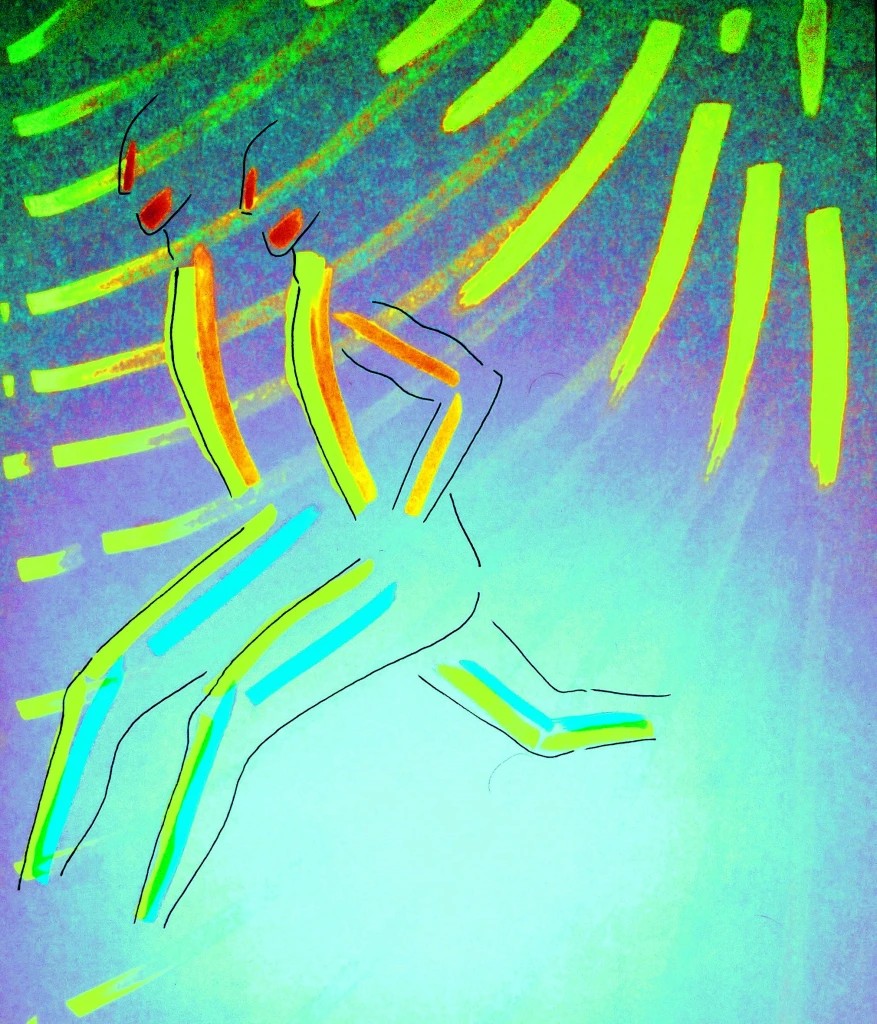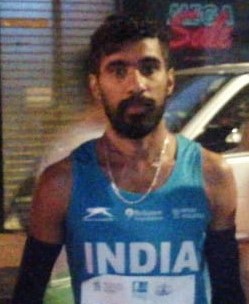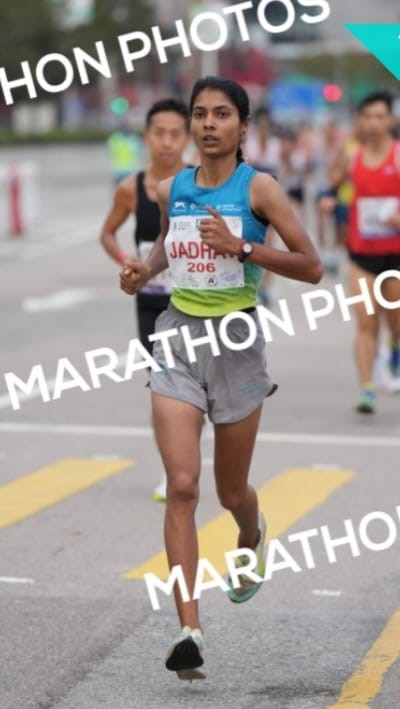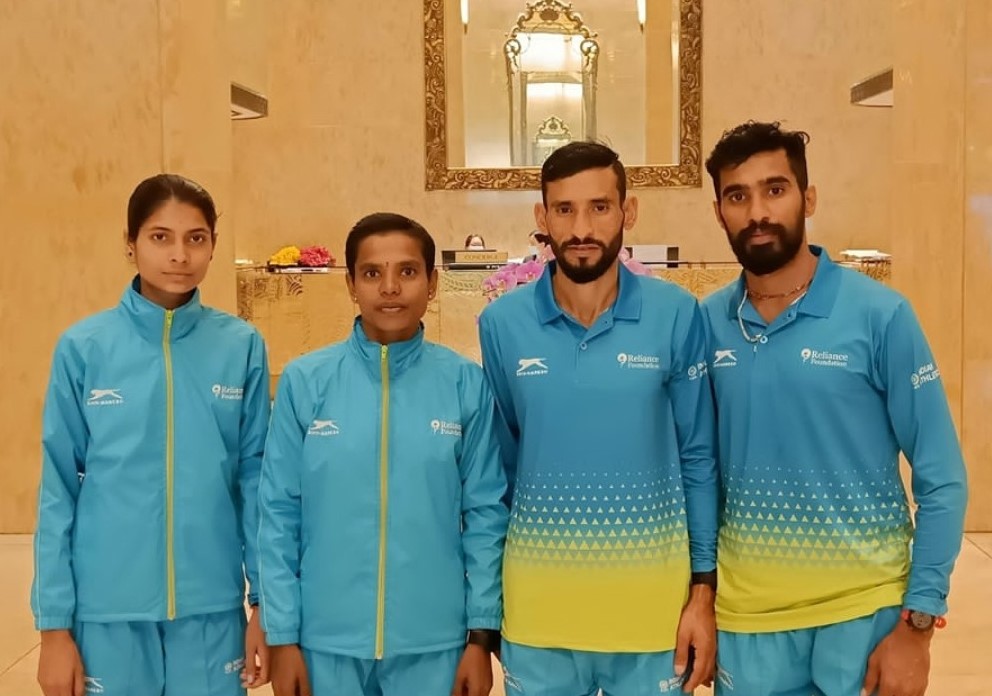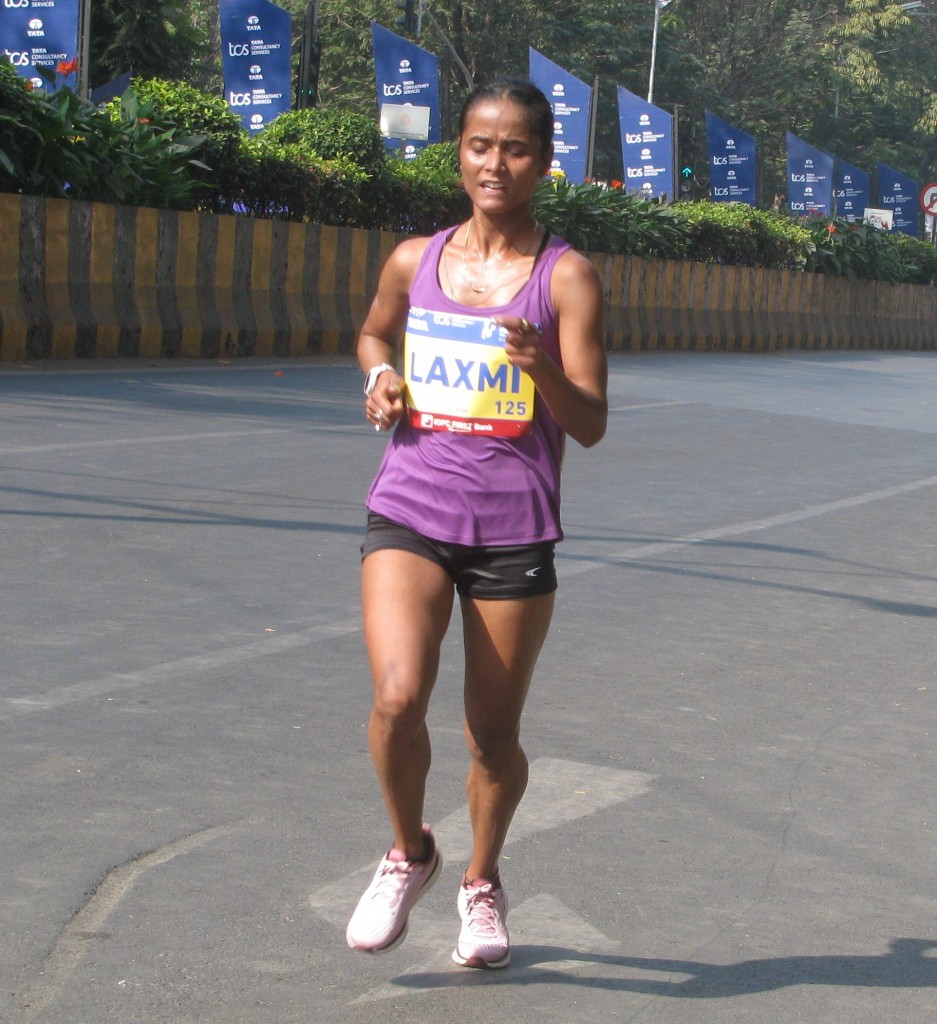Following the 2024 Tata Mumbai Marathon (TMM), we spoke to some of the podium finishers. We also spoke to leading coaches. This article will stay a work in progress for a while, harvesting synopses of runners’ experience at 2024 TMM.
Srinu Bugatha
Sunday’s run signified a return to podium finish in Mumbai, for Srinu Bugatha. A former winner among Indian elites at the Tata Mumbai Marathon (TMM), in 2023, he had however finished fifth among Indian elite men with a time to finish of 2:23:05. Speaking to this blog a couple of days after the 2024 race, Srinu said that he had suffered from a hamstring injury for much of the previous year. He had October, November and December and events therein to get ready for 2024 TMM. According to him, on January 21, race day of the 2024 edition of TMM, he started off well and could maintain a pace that was designed to cover the distance in two hours 15 minutes, till around the 35th kilometer. The weather was cooler than usual and supportive. However, over the final three to four kilometers of the course, Srinu’s pace declined. It showed in his splits – 18.7 kilometers per hour, 18.8, 18.7 and 18.5. He emerged winner among Indian elites with timing of 2:17:29. The elite athlete is now focused on improving his timing further and has his eyes set on suitable races overseas.
Gopi Thonakal
For Gopi Thonakal, the Indian marathoner with the best timing since the late Shivnath Singh’s still standing national record from 1978, the 2024 Tata Mumbai Marathon (TMM) didn’t play out as planned. In December 2023, he had run the Tata Steel 25K in Kolkata. At that race, he developed stomach cramps after 21 kilometers and had to give up. It was a Did Not Finish (DNF). From that race to the 2024 TMM wasn’t a long while and Gopi had to train within safe parameters, one of which was that his long runs in training didn’t exceed 31-32 kilometers. “ It affected my endurance,’’ he said. On January 21, 2024, race day in Mumbai, Gopi found the weather quite supportive. Knowing from previous experience the nature of the course, including the construction work of Mumbai’s metro being on, he had no complaints in that department. It was to be expected; he was ready for all that. However, even as the race started well for him, at around 27 kilometers, his calf muscles began to cramp up. The situation was bad enough for him to require stopping and stretching. By then, the gap between him and the race leaders had increased and those immediately behind had caught up or got past. While stretching eased the pain, the cramps recurred multiple times over the next 15 kilometers. “ I had to stop and stretch some 5-6 times,’’ Gopi told this blog after the race. His splits tell the story – 18.8 kilometers per hour, 18.8, 18.6 and 18.3. Eventually he finished second among Indian elite men with timing of 2:18:37. Gopi said that he had come to Mumbai, hoping to run a 2:15.
Sher Singh Tanwar
Hours after the 2024 TMM, Sher Singh was a picture of happiness as he voluntarily donned medal and head gear to pose for a picture. In the run-up to the event, the Rajasthan Police sub inspector had seen his focus distracted and his training nudged sideways a bit as he was forced to participate in a cross-country competition. Cross-country events span shorter courses compared to the marathon and typically due to that, entail more speed. That upset the sort of training he would have liked to have for TMM. He found the conditions in Mumbai on race day, quite agreeable. It wasn’t very warm. His run proceeded well for about 30-34 kilometers. Then he started to get cramps in his hamstrings and calf muscles. Unlike Gopi, Sher Singh didn’t require stopping and stretching. But his progress was slowed down. Sher Singh’s splits were – 18.8 kilometers per hour, 18.8, 18.6 and 18.2. He finished third among Indian elite men with a timing of 2:19:37. Sher Singh said that he would like to participate in races overseas.
Aasa T.P.
Aasa T.P. started running in 2018 after doctors asked her to take up this activity as a means to combat stress. She commenced with a 6 km road race and then moved on to 10 km, half marathon and the full marathon.
In the absence of races during the COVID-19 pandemic Aasa’s running suffered a setback. A certified nurse, Aasa worked at Mumbai’s Bhatia Hospital. In January of 2023 she quit her job and decided to focus on training. She came in touch with Kenyan athletes and found help in terms of training plans as well as financial support. To focus on her training, she shifted to Bengaluru staying in a rented pad at Whitefield.
In May 2023, Aasa ran the Federal Bank Kochi Marathon. She finished overall third with a timing of 3:18:58, behind Jyoti Gawate and Ashvini Jadhav, both elite runners representing India in marathon and ultra-marathon events. A single mother, Aasa is now dependent on the money she earns from podium finishes at running races. Originally, a resident of Thalakode, Kothamangalam in Kerala’s Ernakulam district, she travels around for her races. “ My son lives with my parents and my siblings. Initially, my parents were not keen about my running activity but now they support me fully,” she said.
At Vasai Virar Municipal Marathon (VVMM) 2023 held on December 10, 2023, Aasa won the marathon in the open category with a timing of 2:55:18. “ A day before the VVMM race, I was trying to repair my running shoes when an Ethiopian runner offered me her running shoes. I ran VVMM in those shoes but they were small for my feet. By the end of the race, my feet were full of bruises,” she said. Aasa ran the 2024 Tata Mumbai Marathon also in those shoes but after having cut out some gaps to make it easier for her to run in them. Given her financial constraints, she is not able to afford performance shoes.
“ My training for Mumbai Marathon was quite good. Weather, route and support were excellent. If I had better shoes, I would have been able to run better,” she said. Aasa was the overall winner among women in the open category. She finished TMM in 3:08:08. She also won in her age category (35-39 years).
Next on the cards is the New Delhi Marathon of February 2023.
Kavitha Reddy
In the past four months, Kavitha Reddy had four major outings in the word of running. Starting with the Melbourne Marathon in October 2023, Kavitha then represented India at the IAU 50 km World Championships in Hyderabad in November 2023, followed by the Antarctic Ice Marathon in December and Tata Mumbai Marathon in January 2024.
In the intervening period, Pune-based Kavitha had been largely focussed on recovering from each of these events. “ I had very little time for proper training. My training for the last three events were far from adequate,” she said. Kavitha’s original plan was to focus on training for the marathon at TMM 2024 but she was suddenly swamped with events including the 50 km world championships and the Antarctica Ice Marathon. The 50 km world championship was an opportunity for Kavitha to go beyond the marathon distance. Additionally, she was representing India in the event. The Antarctica Ice Marathon, on the other hand, was a completely different experience. The travel, weather, running on slippery snow and the extremely strong winds were quite challenging. “ It was a great experience,” she said.
Once back in Pune, she barely had a month before TMM 2024. “ I managed one week of good mileage and some decent speed workout,” she said. At the 2024 Tata Mumbai Marathon, she ran at a consistent pace and stayed strong throughout the run. “ After 2017, I had not run a full marathon here. I was looking forward to run the marathon this time. It was a good race for me,” she said. Kavitha finished in third position overall among women runners and secured a first position in her age category of 45-49 years. Her timing was 3:12:13. She is now due to participate in the 2024 Boston Marathon this April, her third time at the World Marathon Major.
Team Meghalaya

At the 2024 Tata Mumbai Marathon (TMM), Kmoin Wahlang ran in the age category of 75 years and above for women. Hailing from Mawkyrwat in Meghalaya, she farms, has a dozen children and nearly two dozen grandchildren. Kamoin ran the marathon at TMM at an average pace of 9.4 kilometers per hour to complete the 42.2 km-distance in 4:29:24. Her first split was at 8.9 kilometers per hour; the fastest split (the third one) was at 9.7 kilometers per hour and her final split (the sixth) was at 9.5 kilometers per hour. Needless to say, she stood first in her age category. The story of Kmoin’s performance doesn’t end there. At the 2023 TMM, when too she had placed first in her age category of 70 years and above, she had finished in 4:48:10. In other words, a year older and into the 75 plus age category, the grandmother from Mawkyrwat had become almost 19 minutes faster! Her timing in 2020 at TMM was 4:44:09 and in 2019, it was 4:33:56. Speak to the team of runners from Meghalaya who annually visit Mumbai for the marathon and it is Kmoin that they now unfailingly talk of. From the rest of the team, Tlanding Wahlang who has been a dependable performer at TMM, secured first position in his age category with timing of 2:44:18. Snora Lyngkhoi (4:09:44) finished seventh in her age category of 50-54 years and Darishisha Iangjuh (3:29:37) placed third in her age category of 25-29 years. Sustaining a constant pace Gerald Pde, covered the distance in 3:38:43 while Dr K.G. Lynrah, one of the main sponsors of the running team and participating in the 55-59 years age category, finished in 6:19:01.
Dixon Scaria
Years ago in Kerala, Dixon Scaria used to participate in athletics in school. He kept up his running, even after he shifted to Abu Dhabi on work. “ Most days, I used to run for an hour,’’ he said. Following his retirement and return to Changanassery, he and others around, started a running club. The first city marathon he participated in, was in Bengaluru. From then on, he has participated in several events. In 2023 for instance, Dixon estimates he must have run 3-4 marathons and 10-15 half marathons at various locations. This included a first place in his age category of 70 years and above at the 2023 Tata Mumbai Marathon (TMM); he covered the 42.2 kilometre-distance in 3:52:29. In Changanassery, he trains six days a week. According to him, this includes a day to run 10 kilometres, another for 30 kilometres, one day for interval training and high intensity workouts and at least three days devoted to strengthening exercises and recovery, with one off-day. Dixon said that he approached 2024 TMM with his regular training done and without any special preparation. “ This year’s marathon went off smoothly for me. I faced no problems. One good thing was that the hydration support was excellent; they provided water in small bottles, which you could carry along. I didn’t feel very tired at the finish line,’’ he said. He maintained a steady, consistent pace. Dixon improved his timing; at 2024 TMM he clocked 3:49:00 and placed first in his age category of 70-74 years. Gong ahead, among races he is scheduled to participate in, is the 2024 Boston Marathon in the US. It will be his first World Marathon Major. However, he has run in the US before including a first place secured in a 10K at an event in Atlantic City.
Sabhajeet Yadav
Sabhajeet Yadav, farmer from Dabhiya village in Jaunpur district of Uttar Pradesh, is well-known among recreational marathon runners. He has been running marathons for several years, very often securing a podium finish in the process.
In recent years, he is also known as the father of the promising national level javelin throw-athlete, Rohit Yadav. Rohit has represented India in international events. Every year for the Mumbai Marathon, Sabhajeet travels from his village to Maharashtra’s capital by train. In the initial years of the event, he used to sleep at the railway station, get up in the morning, run the race, secure a podium finish and head back. For the past couple of years, New Vasantashram Hotel, a boarding hotel near CSMT (Mumbai’s main railway station), has been hosting Sabhajeet free of cost.
Sabhajeet was not able to train ahead of the 2024 Tata Mumbai Marathon as it was very cold in his village. But his race went off quite well. I ran quite easily throughout without any trouble,” he said. He finished the marathon in 3:23:51, winning in his age category of 65-69 years. He said his pace suffered during the last few kilometres as the cool weather started to wane. `` Also, this time around there were too many runners,” he said. Nearly 56,000 people participated across categories in the 2024 Tata Mumbai Marathon. Once a regular at many running events, Sabhajeet has reduced his outings now, to a select few.
Deepa Nayak
Having signed up for the Tokyo Marathon, Deepa Nayak’s training was focussed on that race. “But I did not want to miss TMM. I decided to take it as a training run,” she said.
The Bengaluru-based runner and coach has been into running for the last 12-13 years.
“ My training went off quite well. I commenced my training in November. Everything went as per the plan. It was a well scripted run,” she said. She was able to maintain her pace comfortably throughout the run, helped partially by the weather conditions in Mumbai on race day.
She finished the marathon in 3:20:31 securing a fourth position among women in open category; she was also winner in her age category of 30-34 years.
She will now focus on training for the Tokyo Marathon. Last year, she did Boston Marathon and London Marathon back-to-back.
Team Ladakh

The team of Ladakhi runners that come to Mumbai annually for the Tata Mumbai Marathon (TMM) is now well-known to the city. This year’s edition of the event was however not exactly among their best outings in Mumbai. Jigmet Dolma, their elite runner with a personal best of two hours and 56 minutes in the women’s marathon, was a bit challenged preparing for the event. Part of Ladakh’s traffic police, she had to be on duty in the evening hours. This meant that unlike the regular elite athlete, who trains both morning and evening, Jigmet had only the morning hours to train. In Mumbai, the weather on race day was better than usual. Unfortunately, at around 31-32 kilometres covered, she started to get pain in her shoulder and hamstring. It reached a point, where she felt it wise to stop and walk a bit. “ I tried my best but there was no other alternative,’’ she said. Jigmet finished sixth among Indian women elites with timing of 3:14:09. Another major hope for Ladakh was Nawang Tsering, the young runner who has churned out some remarkable timings in the marathon at Leh’s high altitude. However, according to Jigmet, he was nursing an injury. He finished in 2:43:56 to place seventh in his age category of 25-29 years. But the team did get two podium finishes. With timing of 3:22:08, Disket Dolma topped her age category of 25-29 years for women in the marathon while Stanzin Chondol (1:28:42) placed second in her age category of 25-29 years in the half marathon. Post-TMM, the team was set to train for the marathon in Delhi due in February.
Gitanjali Lenka
Race after race Thane-based Gitanjali Lenka has been improving her personal best in the marathon.
At Tata Mumbai Marathon 2024, she finished the 42.2 km-race in 3:28:42, a new personal best. She also won in her age category (50-54 years) and finished eleventh overall among women runners. “ My training was good. I had planned to do a sub-3:30. I achieved my target,” she said. Pleasant weather helped along the way. “ I had an effortless run. I am quite amazed that my fitness level has been improving,” she said. She trains under coach Ashok Nath.
A month ago, at the Vasai Virar Municipal Marathon Gitanjali had secured an age category (50-59 years) win in the half marathon category with timing of 1:44:22. Post-TMM, she will be running the Thane Hiranandani Half Marathon and the 50 km race at Tata Ultra. Following these races, Gitanjali plans to focus her training on the upcoming London Marathon, slated to be held on April 21, 2024.
Avik Pal
During his schooling days in West Bengal Avik Pal was into the 100 metres sprint. He also participated in team sports. His mother Ratna Pal was a sprinter and long jumper. She had represented the state in these events. “ She was the one who encouraged me to take up sports,” Avik said.
However, over the years his focus on sport diminished to some extent. He joined Wipro in Hyderabad in 2011. In 2015 he resumed running by chance at the Spirit of Wipro run that year. “ I just landed at that run wearing jeans and t-shirt. The idea of running five kilometres was too much because I was used to the 100-metre dash,” he said. He took to running after this event in a slow manner; he ran only on Sundays. The next year he trained for the Spirit of Wipro run. Soon, he was running 10 kilometres and half marathon races.
At the 2017 Tata Mumbai Marathon, Avik ran the full marathon without any training. He finished in 3:50:38. The same year, he started training with Bengaluru-based Coach K.C. Kothandapani, (popularly referred to as Pani Sir). The remote training (Avik was based in Hyderabad and Kothandapani in Bengaluru), helped him improve considerably.
Over the years, besides his coach’s inputs, Avik came up with his own strategies. It started to show in his timing. At the 2022 Ahmedabad Marathon, he touched his best timing yet for a marathon (2:37:50).
For the2024 Tata Mumbai Marathon, Avik, 34, started training in November 2023. Having suffered a bout of COVID-19 infection earlier in the year, Avik said he took a long time to get back to feeling fit. “ By November I started to feel fine,” he said. “ At TMM 2024, my run went off quite well until I hit a wall of 10 km runners at the tail end of the marathon route. I had to slow down because I just could not get past the crowd of runners,” he said.
He finished in 2:40:07, securing a ninth position overall in the open category and second place in his age category of 30-34 years.
Nirupma Singh
Nirupma Singh, a runner and coach, has been into fitness and running for over 20 years. “ I took to fitness to lose weight and combat depression,” she said. Over the years she went on to certify as a fitness trainer.
In 2009, she ran her first race – the Airtel Delhi Half Marathon. “ Within a year, I did the full marathon,” the Bengaluru-based recreational athlete said. Nirupma has secured many podium finishes.
Her personal best in half marathon in terms of timing efficiency has been the Delhi Half Marathon of 2017, when she finished in 1:34. She set a personal record in full marathon during the 2023 edition of Berlin Marathon with a finish of 3:32.
Running the marathon at TMM 2024, Nirupma finished in 3:39:34 securing a second position in her age category (50-54 years). “ My training for TMM was good but my performance on race day did not justify my training,” she said.
Within a few kilometres from the start line, Nirupma realised that she could not keep up with her plan. “ I went for plan B as I wanted to finish gracefully. It was a blissful run for me,” she said.
This year she plans to do the Chicago Marathon. She has also registered for the Boston Marathon but may opt to sit out. “ I have been qualifying for the Boston Marathon for the past six years but I am not too focussed on the World Marathon Majors,” she pointed out.
Her goal in running now is to improve her timing efficiency to around 3:22-3:23. “ Once I achieve this, I may look at a 50 km-run,” she said.
Anil Korvi
A resident of Ambarnath, a suburb on the outskirts of Mumbai, Anil Korvi has been running since his college days. His initial races were short distance ones and cross-country events.
“ In 2011, I ran a full marathon but a friend advised me against it. I was just 21 years old then. I took up full marathon in 2016,” he said. Anil has been getting podium finishes in many of his outings across the country.
At TMM, he chose to run the half marathon as he was nursing an injury to his shin. He ran the distance in 1:12:46 securing an age category win (30-34 years). Two weeks ago, Anil ran the half marathon at Vadodara Marathon with a timing of 1:15:14. He finished overall fourth and secured a win in his age category of 30-34 years.
Anil Korvi has been chosen to run at the world railway marathon championships and is awaiting official communication in this regard. His training will now focus on that event, he said.
Pervin Batliwala
For the last two years, Pervin Batliwala has opted to run the half marathon. In 2023, she was training for Tokyo Marathon and therefore chose to do the half marathon instead of her preferred full marathon. The 69-year-old recreational runner had completed her six-star World Marathon Major circuit at the 2023 edition of Tokyo Marathon.
This time around at the Tata Mumbai Marathon (TMM) she was able to race as per her training plan. “ Whatever I trained for, I got,” she said of her 2:12:28 finish, which gave her a second place in her age category of 65-69. Earlier at the Vasai Virar Municipal Marathon, Pervin had secured a second place podium in her age category of 60 years and above.
“ At TMM 2024, I enjoyed the run. Weather was quite good but there were too many runners this time,” she said. Pervin arrived late at the start line because of logistics issues and she commenced her race without any warm-up.
In February 2024, Pervin will be doing a one km swim at the Goa Swimathon 2024. Following this swimming event, Pervin plans to take a break and restart when the running season commences with the arrival of the rainy season.
Thomas Pallithazhath
Thomas Pallithazhath, a resident of Wayanad, Kerala, has been running for many years and often secures age category podium positions. Working as a driver he has managed to carve out time for training in between his strenuous work schedule. Thomas now works at Aramaia International Residential School at Wayanad as a clerk but his job entails driving and running errands.
“ I wanted to run the full marathon this time but I am not able to find time for training,” he said. His work at the school keeps him busy for long hours. He stays 9 km away from the school. “ My training for the half marathon at TMM 2024 was not consistent. I would every now and then run to my school early morning, shower there and get to work,” he said, adding, “ the days I run, I wake up at 4 AM and set out for a run in my running clothes till the school. Once at school, I shower and change into work clothes,” he said.
The night before the run at Tata Mumbai Marathon 2024, Thomas said he did not sleep well. “ My run was however very good; the route was superb and the weather was awesome. Had I slept well the previous night I would have been able to do better,” he said. Thomas finished the half marathon in 1:32:03, securing a second position in his age group of 60-64. “ The only problem along the route was coping with the rush of runners. It was too crowded this time,” he said.
He will now be participating in Manipal Marathon 2024, due to be held on February 11, 2024.
The other side of 56,000
Having 56,000 participants (the overall numbers registered for 2024 TMM, as per media reports) is one thing. Making the experience enjoyable for runners is another. Given it has been a pioneer of sorts in India’s city marathon space, it will probably fall to the Tata Mumbai Marathon (TMM) to imagine how the event should be when participant numbers rise. Based on the chats we had with coaches and runners, there could be a fork in the journey approaching. It starts with two realizations and the courage and grace to accept those realizations.
First, given the nature of the course in Mumbai and the weather conditions, TMM lacks the profile of an event tracked for fantastic performance from elite athletes. It offers good prize money but it is not associated with great elite timings when compared to other international city marathons. For runners, its core attraction lay in overall size, that Mumbai spirit, crowd support (this year the crowd support was less, likely due to the cool weather) and positioning as India’s premier marathon.
Second, as the number of participants and the number of distance categories in races at TMM have risen, so has the congestion experienced by runners. The numbers are highest in the Dream Run, which is among TMM’s charity events. The congestion is felt in the second half (return half) of the marathon when multiple races and at least one charity walk converge on to the same path. As one senior coach pointed out, although personal bests are still recorded and the event remains a great outing for amateurs at large, the emergent congestion has become a challenge for any amateur capable of three hours and thereabout, less than three hours or hoping to run such marathon timings in Mumbai. What makes the challenge particularly so, is the ongoing construction work which has resulted in roads getting narrow in places. There is the impact of the city’s coastal road project and the construction of a section of its metro rail system.
Of these two projects pinching the marathon route, work on the coastal road is expected to be largely over by the next edition (2025) of TMM. “If the number of participants continues to rise, then 2025 could be a litmus test as we will get to know how the numbers fare with much of the route unclogged. If it stays congested still, then we likely have a real problem,’’ one coach we spoke to, said. The alternative most frequently cited in the conversations we had, was to split the event into at least two days so that the experience of running stays undisturbed. “ The flagship category of the event is the marathon. So, maybe have the marathon and the Dream Run on one day; the half marathon and the 10K – which will remain races gathering more numbers – on another,’’ said one of the coaches. Needless to say, this will call for greater cooperation and understanding from civic authorities but that’s how the world’s great city marathons have evolved. “ Boston for instance, does not mix up races,’’ a senior coach said. Perhaps we should consider the following thought. Mumbai showed the way for a great city marathon in India. Maybe its time for the city to host a multi-day festival of running?
Meanwhile, on a more practical note, one of the coaches we spoke to had a suggestion. “ The half marathon and the marathon now start very early to take advantage of the cooler weather. Unfortunately, some of the portions of the route were poorly lit this time. It would be good if the race organizers ensured there is proper lighting all along the route for lack of adequate light compounds the challenge of running on narrow roads maintained to typical Indian standards,’’ he said.
(The authors, Latha Venkatraman and Shyam G Menon, are independent journalists based in Mumbai. Our thanks to everyone who spoke to us)















